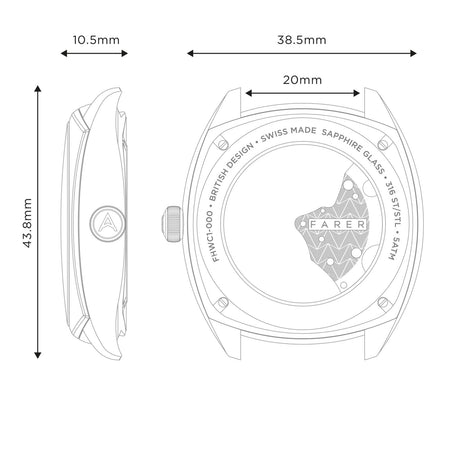Halley
MOONPHASE
 Free Shipping
Free Shipping
 5 Year Guarantee
5 Year Guarantee
 30 Day Returns
30 Day Returns
- Case size: 38.5mm x 43.8mm x 10.5mm
- Case Material: 316L marine-grade stainless steel
- Water Resistance: 50M / 5 ATM
- Movement: Swiss Made Sellita SW288-1 Ma Elaboré Grade movement, blue screws with bespoke Farer embossed patterned bridge
- Power Reserve: Approximately 45 hours when fully wound




Short 14cm - 17.5cm wrist
Regular 16cm - 22cm wrist
Long 18cm - 24cm wrist
Halley
Pairs well with

MIDNIGHT MOON
The hand-painted yellow moon of the Halley shines brightly against a glossy midnight blue dial. The centrepiece of the dial is naturally the large moonphase aperture with its yellow moon that contrasts perfectly with the rich midnight blue of the dial. The moonphase disc is hand-painted (not printed) in Switzerland. Each features a starry sky with two moons painted onto it. Each moon is crafted from Super-LumiNova and features a hand-applied, subtly textured surface reminiscent of the lunar landscape.
In nature, a yellow moon occurs when the moon is viewed close to the horizon. This is because the blue light has been scattered through the Earth’s atmosphere, leaving only the warmer yellow and red tones, which are accentuated by dust particles in the air. Alongside this eye-catching complication sit bright white numerals and batons moulded from Lumicast, a composition of ceramic and Super-LumiNova. These are paired with a flawlessly polished lance handset and a seconds hand tipped with the Farer “A” in burnt orange.
FEATURES

Lunar Orbit - Each moonphase disc is hand-painted in Geneva, Switzerland and features a textured moon set against a starry sky. What’s more, the moons themselves are painted using Super-LumiNova so that they glow brightly in the dark.

Curvaceous Comfort - The cushion case sits comfortably on any wrist, with a thickness of only 10.5mm and a compact lug-to-lug of 43.8mm.

Manual Drive - The watches in the Moonphase collection are powered by Swiss hand-wound mechanical movements with custom decoration, which can be viewed through a sapphire case back.

Moon Light - The watch features hour markers made from Lumicast, a blend of ceramic and Super-LumiNova that offers unbeatable legibility at night. Naturally, the hands are also filled with Super-LumiNova.
STORY
The Halley takes its name from Edmond Halley, the famous English astronomer whom Halley's Comet was named after. Born in 1656, Halley took a keen interest in astronomy from a young age and would be responsible for several notable experiments and theories throughout his life. He was the first to map the Southern stars, and whilst doing so realised the future observation of the transit of Venus between the Sun and Earth could be used to trigonometrically calculate the distances between Earth, Venus, and the Sun.
In 1682, Halley observed what would become known as Halley’s Comet, going on to use Isaac Newton’s laws of motion to accurately predict its return in 1758, which he sadly never lived to see. Halley helped Isaac Newton publish his book, Philosophiæ Naturalis Principia Mathematica, in 1687, in which Newton expounds upon his laws of motion and gravitation, which is regarded as one of the most influential scientific books in history. In 1720, Halley succeeded Flamsteed as the second Astronomer Royal, a position Halley held until his death in 1742 at the age of 85.

Tech Specs

Dimensions
| Diameter | 38.5mm |
| Depth | 10.5mm |
| Lug-to-Lug | 43.8mm |
| Pin-to-Pin | 41mm |
| Lug Width | 20mm |
Case Material
316L marine-grade stainless steel
Case Finish
Polished, with brushed bezel chamfer and "grain twist' pattern on flanks
Glass
Curved sapphire crystal with multi-layer anti-reflective coating on the underside. Sapphire exhibition glass on case back
Dial
Midnight blue gloss dial with applied numerals and markers made from Grade OL X1 Super-LumiNova. Hand-painted blue moonphase disc with a yellow moon in Grade OL X1 Super-LumiNova
Hands
Polished lance handset, applied with Grade OL X1 Super-LumiNova, and with burnt orange tipped polished seconds hand
Crown
Rounded stainless steel with solid bronze cap insert featuring embossed Farer 'A'
Strap
St. Venere leather, 316L stainless steel buckle fastening
Water Resistance
50M / 5 ATM
Movement

Movement
Swiss Made Sellita SW288-1 Ma Elaboré Grade movement, blue screws with bespoke Farer embossed patterned bridge
Vibrations
28,800 vibrations per hour (4 Hz)
Functions
Hours, minutes, sweep second. Hacking seconds for precision time setting. Quickset date and moonphase display.
Winding
Manual winding
Jewels
18
Power Reserve
Approximately 45 hours when fully wound
Fitting

wrist circumference of 5.9 inches - 15cm

wrist circumference of 6.9 inches - 17.5cm

wrist circumference of 6.9 inches - 17.5cm
Press
The Farer design team definitely aced their exams in school because these watches just have amazing proportions and great colours, and always bring something new to the table.→
When I find out one of the most design-conscious British brands is tackling this most traditional complication, my curiosity is piqued.→

























 Brown Suede Leather Strap
Brown Suede Leather Strap Gull Grey Granolo Leather Strap
Gull Grey Granolo Leather Strap Pilot Blue Granolo Leather Strap
Pilot Blue Granolo Leather Strap Lion Tan Granolo Leather Strap
Lion Tan Granolo Leather Strap Octane Petrol Granolo Leather Strap
Octane Petrol Granolo Leather Strap Avocado Green Granolo Leather Strap
Avocado Green Granolo Leather Strap Navy St. Venere Leather Strap
Navy St. Venere Leather Strap Black St. Venere Leather Strap
Black St. Venere Leather Strap Grey Suede Leather Strap
Grey Suede Leather Strap Denim Suede Leather Strap
Denim Suede Leather Strap Milanese Bracelet
Milanese Bracelet Black Rubber Strap
Black Rubber Strap Navy Rubber Strap
Navy Rubber Strap






